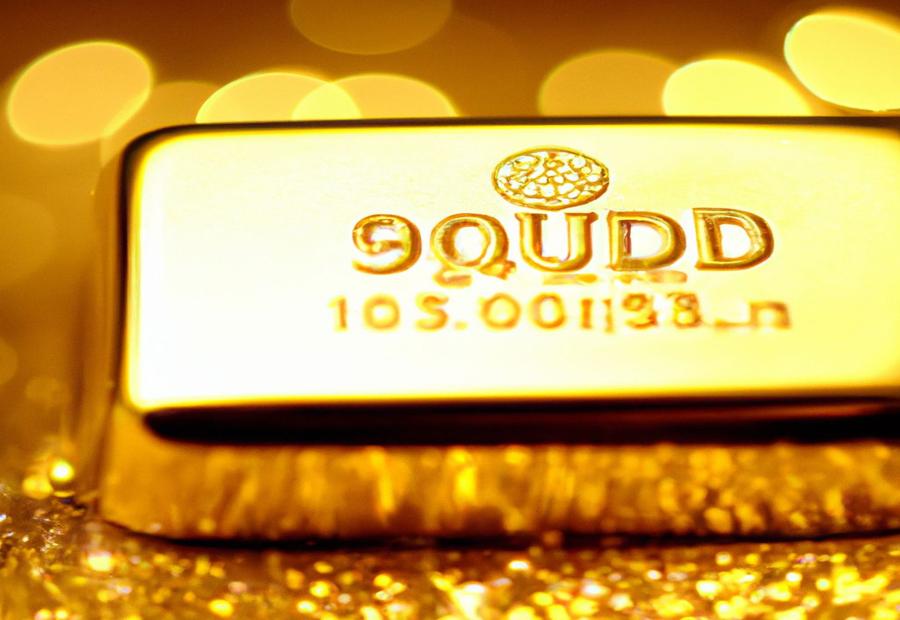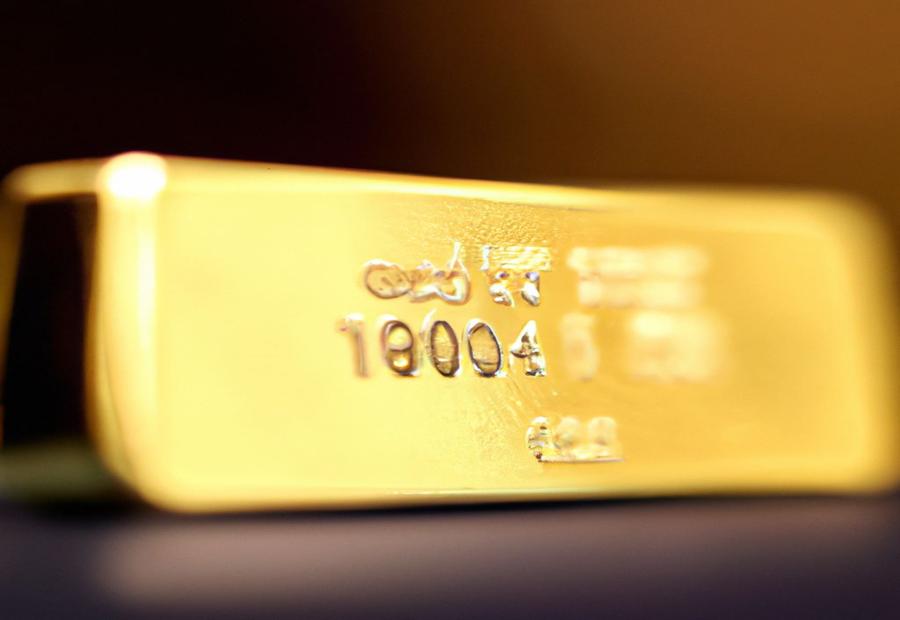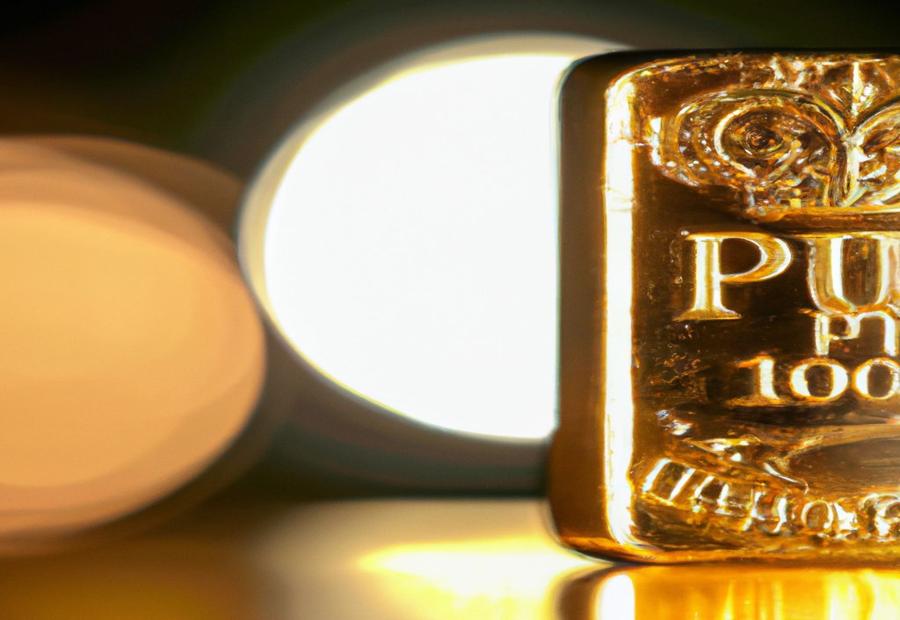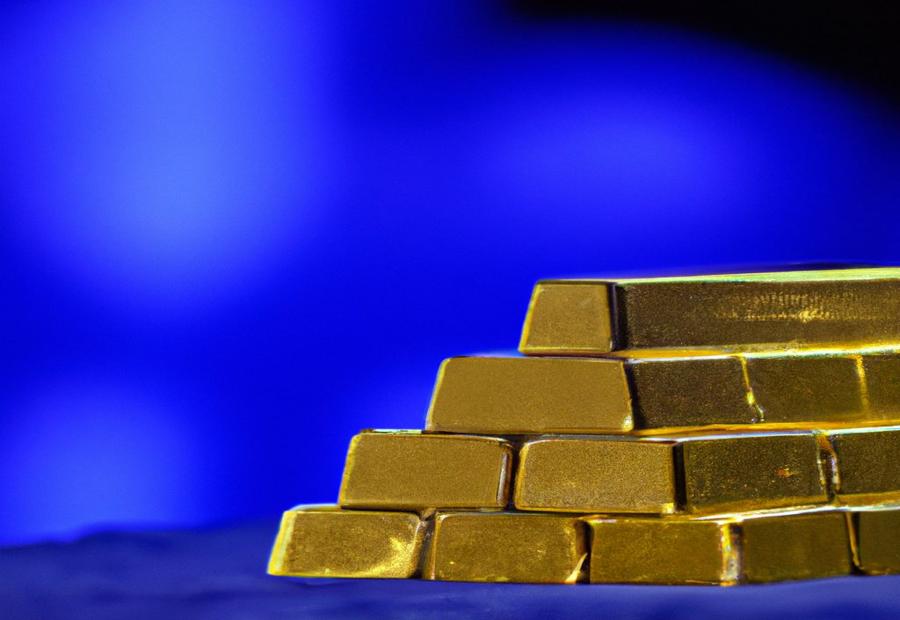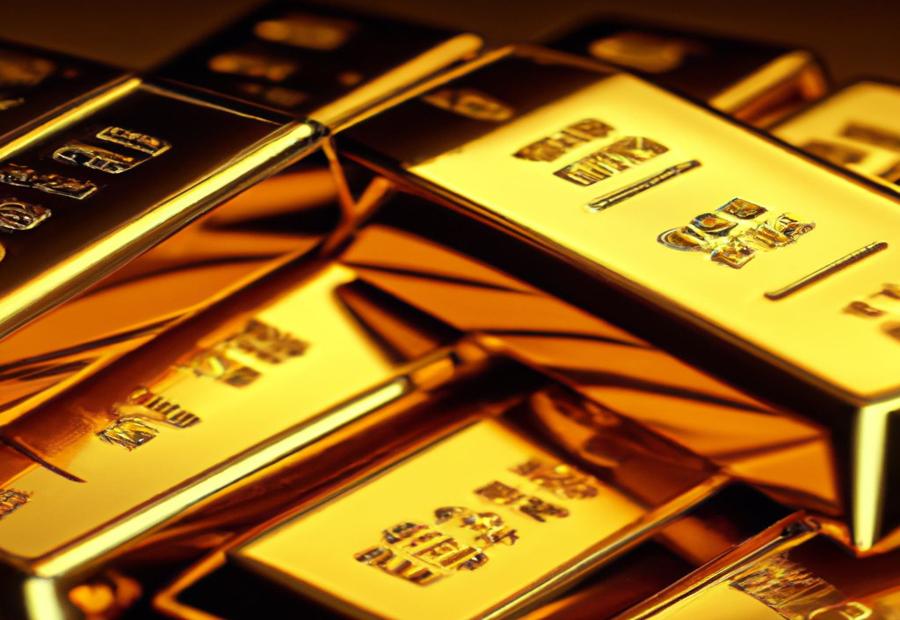Key Takeaway:
- The value of gold is influenced by various factors such as supply and demand, economic conditions, political and geopolitical factors, interest rates, and inflation.
- The calculation of the value of a pound of gold involves considering the spot price of gold and determining its value based on market conditions and the marketplace for buying and selling gold.
- Investing in gold offers benefits such as diversification and hedging against inflation, but investors should carefully consider their investment goals and market conditions before making investment decisions.
Introduction to the Value of Gold
Photo Credits: Ecopolitology.Org by Arthur Nguyen
Gold, with its enduring value and historic significance, holds a prominent place in the financial world. In this section, we will explore the importance of gold in today’s financial landscape and delve into its rich historical significance. From its role as a hedge against inflation to its status as a symbol of wealth and power throughout centuries, the value of gold goes beyond mere monetary worth. Join us as we unravel the fascinating journey of this precious metal and understand its place in the world.
Importance of Gold in the Financial World
Gold has huge importance in the finance world. It’s more than a precious metal – it’s a symbol of wealth and a safe investment for people and corporations. It’s a store of value, protecting people during financial instability. It hedges against inflation, as its worth rises when currencies drop. Plus, it diversifies investments, reducing risk. It’s also used as a reserve asset by central banks. And, gold is resilient when tensions or crises arise – investors often flock to it for shelter.
But, gold’s worth is affected by many factors, like supply/demand, economics, politics, rates & inflation. Investors must monitor these to make good decisions. As markets are complex and there are economic issues, people worry about missing out on gold benefits. By staying alert to local & global developments, you can take advantage of changing gold prices. Understanding the precious metal’s role in finance can help you to gain financially.
Related Post:
How Much Is Italian Gold Worth
How Much Is 50 Grams of 24K Gold Worth
Historical Significance of Gold
Gold has always been special. From olden civilizations to modern times, it’s been respected for wealth, power, and prestige. It’s been used to store value and measure wealth across cultures. Gold’s rarity and appeal make it a symbol of prosperity and financial security.
The Egyptians prized it for its beauty and thought it was divine. Ancient Romans minted gold coins as currency. During wars and financial crises, people turn to gold as a safe investment. The Great Depression saw governments in Europe take private gold holdings to stabilize.
Now, gold is a great protection against currency devaluation and geopolitics. Investors use it to diversify portfolios and safeguard against losses. The global landscape is ever-changing, so it’s important to understand gold’s historical significance.
Don’t miss the chance to benefit from gold’s historical power today! Consider adding this significant asset to your investment portfolio. It can provide stability and protect you in volatile markets. Unlock the historical significance of gold for your financial future now!
Understanding the Measurement of Gold
Photo Credits: Ecopolitology.Org by Dylan Lopez
Gold is a coveted precious metal, but understanding its measurement can be confusing. In this section, we’ll explore the difference between a troy ounce and a pound when it comes to weighing gold. Hold on tight as we unravel the intricacies of gold measurements and dive into the world of weights and valuations.
Difference Between Troy Ounce and Pound
Gold is weighed and exchanged in different units. The two main ones are the troy ounce and the pound. The troy ounce is usually used for valuable metals like gold, while the pound is a regular weight unit. It is important to know the difference when trading or buying gold.
This table shows the difference:
| Measurement | Troy Ounce | Pound |
|---|---|---|
| Definition | A standard measurement for precious metals | A unit of mass |
| like gold | ||
| Size | About 31.1 grams | About 453 grams |
| Conversion | – | 14.5833 |
A troy ounce is a special measurement for valuable metals like gold. It weighs 31.1 grams, bigger than an avoirdupois ounce. The pound is a general weight unit used daily. For gold, a pound is 453 grams. This makes it 14.5833 troy ounces per pound.
In conclusion, troy ounces and pounds are both weight and measurement units. But they differ in their use and conversion when dealing with gold. Knowing this can help buyers and sellers value and trade gold accurately by weight in troy ounces or pounds.
Factors Affecting the Price of Gold
Photo Credits: Ecopolitology.Org by Paul Brown
Factors Affecting the Price of Gold: Supply and Demand, Economic Conditions, Political Factors, Geopolitical Factors, Interest Rates and Inflation – Let’s explore the various factors that impact the value of gold, from the basics of supply and demand to the intricate influence of political and geopolitical variables. We’ll also delve into how economic conditions, interest rates, and inflation play a crucial role in determining the worth of a pound of this precious metal.
Supply and Demand
Supply and demand are two vital components in deciding the value of gold. The amount of gold available (supply) and people’s wish for it (demand) both have an effect on its market price. Economic conditions, political influences, and geopolitical tensions all influence both supply and demand.
To explain the relationship between supply and demand in the gold market, we can make a chart that shows different factors that affect each one:
| Supply Factors | Demand Factors |
|---|---|
| Economic Conditions | Investment Demand |
| Mining Output | Jewelry Demand |
| Recycling Activities | Central Bank Reserves |
Economic states directly impact both supply and demand for gold. During tough economic times or inflation, investors often look for gold as a safe haven, raising the demand. Yet, when the economy is doing well, investors may look for other investments, reducing the demand for gold.
Mining output affects the supply of gold. If mining activities increase, it means higher supplies on the market, potentially lowering prices. On the other hand, when mining operations shut down or production declines, it decreases supply levels, driving prices higher.
Recycling activities help the supply side of gold. When people sell their old jewelry or scrap gold, it increases the supply. However, economic conditions or price changes can affect people’s willingness to recycle gold.
Jewelry plays a major role in the demand for gold. Jewelry demand is impacted by cultural traditions and economic prosperity in various countries. Countries with high disposable income tend to have a higher jewelry demand.
Investment demand is another factor that influences the demand for gold. This includes investments in ETFs, bars, coins, and other physical gold holdings. During tough economic times or inflation, investors may turn to gold as a safe investment.
Knowing the connection between supply and demand can provide investors and market participants with useful information to make informed decisions regarding gold. It is important to keep track of various factors that influence both aspects to predict potential price movements and opportunities in the gold market.
Economic Conditions
The price of gold is hugely dependent on economic conditions. GDP growth, employment rates, inflation, and monetary policies all have an effect. During times of uncertainty, investors seek gold’s stability, driving up its price. But during economic growth, demand for gold may drop as investors look for higher returns from other assets.
Mining operations may be affected by economic or political issues, too. If a country’s economy is thriving, mining activity may increase to meet demand. But during downturns, strikes or government regulations can affect production.
Economic conditions vary across countries and regions. Government policies, trade agreements, and global market trends all shape the economic landscape. Investors should watch these indicators closely when considering gold investments. Staying informed helps make better decisions about buying and selling.
Gold can provide security and act as a hedge against volatility in traditional financial markets. It has historically maintained its value and often served as a safe haven in times of crisis. Including gold in a portfolio diversifies holdings and may protect from risk.
Political Factors
Political factors can have a great effect on the cost of gold. When there’s turmoil and conflicts around the world, investors often turn to reliable assets like gold, raising its demand and worth.
Government choices, such as fiscal policies, monetary policies, and regulations, can also affect gold’s price. If a government enacts loose monetary policies, it could lead to inflationary fears – making gold more attractive as an inflation hedge.
Political stability/instability in a country can also influence gold’s value. Investors often invest in countries with stable politics, since they offer more predictability. On the other hand, uncertainties in political situations can cause increased demand for gold as a protection.
These political aspects are crucial in shaping the market sentiment and setting gold’s price pattern. It’s necessary for investors to stay informed about geopolitical events and government choices to make wise investment decisions.
Plus, international trade deals, sanctions on countries, and mining/exploration policy changes can also influence gold’s value. So, investors must be aware of these unique details to analyze how political elements could influence gold’s price and create strategies accordingly.
To make the most of these dynamics, investors need to keep up with the global political updates from reliable sources – like news outlets and financial analysis reports. It’s also beneficial to get advice from professionals who specialize in commodities like gold, to gain valuable insights into the potential risks and opportunities in the market.
Geopolitical Factors
Geopolitical factors have a major influence on the cost of gold. These factors refer to political events and changes which can impact the worldwide economy and financial markets. Examples of geopolitical factors are trade disagreements, wars, changes in government plans, and international relations.
These geopolitical factors can both directly and indirectly influence the cost of gold. For example, during times of political unrest or instability, investors often look for safety in gold. This increased demand for gold then increases its price. However, if there is a sense of peace or stability, investors may turn away from gold, causing its price to drop.
Furthermore, geopolitical factors can also affect currencies and interest rates, which in turn affect demand for gold. If a country is facing political instability or a change in leadership, its currency can weaken. This makes gold more attractive to investors, as it is seen as a reliable store of value and protection against currency depreciation.
In addition to these direct effects on gold prices, geopolitical factors can also influence economic conditions globally. If political events cause disruptions in supply chains or trade restrictions, it can have a negative effect on economic growth. This can lead to increased market volatility and uncertainty, making investors seek safety in assets such as gold.
To conclude, it is essential for investors trading or investing in gold to understand and monitor geopolitical factors. By keeping an eye on political developments around the world, investors can prepare for potential shifts in the demand and cost of gold.
Interest Rates and Inflation
Interest rates and inflation have a huge impact on the cost of gold. When interest rates are low, investors move funds from bonds and other investments to gold, as it is a better way to save wealth. On the other hand, when interest rates go up, the cost of gold increases, decreasing demand and thus its price. Inflation also affects the value of gold – when inflation rises, the purchasing power of paper money goes down, making gold a preferred store of value for investors. This increased demand can cause the price of gold to rise.
Furthermore, geopolitical factors also influence interest rates and inflation levels, and thus the price of gold. Political instability or conflicts can cause financial market uncertainty, leading investors to invest in safe-haven assets such as gold. Moreover, economic conditions like recession or slowdown can affect central bank policies regarding interest rates and boost the demand for gold.
The stock market might give you a heart attack, just like calculating the cost of a pound of gold!
Calculation of the Value of a Pound of Gold
Photo Credits: Ecopolitology.Org by Jack Thomas
The value of a pound of gold is determined by various factors such as the spot price, market demand, and the buying and selling platforms available. In this section, we will explore the calculation of the value of a pound of gold, including the spot price of gold and the various marketplaces where gold can be bought and sold. Stay tuned to uncover the ins and outs of how the worth of this precious metal is determined.
Spot Price of Gold
The spot price of gold is the value of gold at a given moment. It’s the cost at which you can buy or sell it right away, without any waiting. This value is based on many things, such as supply and demand, economic conditions, politics, geopolitical tensions, and interest rates. Gold is usually seen as a safe and stable asset, so its spot price is important for traders and investors.
Moreover, the spot price of gold can be changed by international financial events and trends. For example, economic troubles, like recessions or crises, can alter the demand for gold as a safe investment. Similarly, political events, like trade wars or new government policies, can impact the value of gold.
To fully understand the spot price of gold, you need to know where it can be bought and sold. These places can include exchanges, banks, and online platforms. These marketplaces make it easy for people to access the spot price and join in buying and selling activities.
In the end, the spot price of gold is affected by many factors. Knowing these factors can help investors make smart decisions about their gold investments.
Determining the Value
To uncover the worth of gold, you need to understand the things that affect its market price. These include the spot price of gold – the current market price. Specialized places for buying and selling gold are major contributors to the value. By taking these into account, investors and traders can work out the value of a pound of gold.
Let’s look at the table below to find out what affects the worth of gold:
| Factors | Description |
|---|---|
| Supply and Demand | The balance between how much gold there is and how much is wanted |
| Economic Conditions | The economy, such as inflation and growth |
| Political Factors | Government policies and stability |
| Geopolitical Factors | International relations and conflicts |
| Interest Rates | The cost of borrowing money |
Analyzing these factors can help investors understand what influences the value of gold. For instance, when there’s not enough gold or too much demand, the price usually goes up. In times of economic or political trouble, people may invest in gold as a safe asset.
It’s important to note that these factors are all connected. For example, changes in interest rates can influence economic conditions, which then affects supply and demand for gold. So by keeping an eye on these variable factors, people can make informed decisions about their gold investments.
Marketplaces for Buying and Selling Gold
The value of gold is determined through marketplaces dedicated to this precious metal. These provide platforms for investors and individuals to trade based on the spot price and conditions. Options include physical bullion dealers, online gold exchanges, and specialized financial institutions. They offer storage, secure transactions, and liquidity.
Plus, there are secondary markets for pre-owned jewelry or coins. Buyers and sellers can trade directly, without an intermediary.
Don’t miss out on these marketplaces for buying and selling gold. Diversify your portfolio or own physical gold – capitalize on its value. Gold: The only investment that shines brighter than your future!
Investing in Gold and Its Benefits
Photo Credits: Ecopolitology.Org by John Hill
Investing in gold can bring various benefits, including diversification and protection against inflation. In this section, we’ll explore how diversifying your portfolio with gold can mitigate risk and why it can serve as a hedge against inflation. Additionally, we’ll discuss important considerations for investors looking to tap into the potential of this precious metal.
Diversification and Hedging against Inflation
Diversifying and hedging against inflation are two must-do strategies when investing in gold. It can reduce losses and protect wealth from inflation’s negative effects.
Gold provides a safe spot during economic troubles. Usually, its value either stays the same or increases when other investments perform poorly. Gold can also help hedge against inflation, as its value typically climbs with the cost of living. By including gold in the portfolio, investors can lessen inflation’s hit on their wealth.
Also, there are unique details to consider when diversifying and hedging against inflation through gold. For instance, geopolitical factors and monetary policies can affect gold prices, making it a great asset for hedging against economic risks.
If you want financial stability, diversifying with gold is essential. Stay informed of market trends and make wise decisions. Know the factors that change gold’s price and track its historical price trends. This positions you for potential growth and protects against inflation.
Invest in gold to safeguard wealth and secure your financial future. But, remember: gold won’t save you from your mother-in-law’s cooking!
Considerations for Investors
Investing in gold has many benefits. It provides diversification, reduces risk, and is a hedge against inflation. But, investors need to understand the considerations before they make any decisions.
Supply and demand, economic conditions, political and geopolitical factors, and interest rates and inflation all play a role in gold prices. Mining production, central bank sales, and investor buying can influence prices. Gold performs well in times of economic uncertainty.
Geopolitical tensions, government policies, and low interest rates and high inflation can cause volatility in the gold market. Investors must consider the spot price of gold and transaction costs and fees when calculating the value of a pound of gold.
Historical price trends of gold can help investors. Gold recently hit record highs due to various economic and geopolitical factors. But, gold prices can change rapidly and be volatile.
Historical Price Trends of Gold
Photo Credits: Ecopolitology.Org by Charles Thomas
Throughout history, the price of gold has experienced intriguing patterns and fluctuations that have captivated investors and economists alike. By examining the historical price trends of gold, we can gain valuable insights into its past performance. In this section, we will explore the record-high prices that gold has achieved over time, as well as the inherent volatility that characterizes its market. Brace yourself for a glimpse into the fascinating evolution of gold’s worth over the years.
Record High Prices
Gold’s historical price trends show times when it hit significant levels. These reflect the demand and economic conditions influencing its value.
To show these high prices, a table can be made. It will have Year, Price in USD/Troy Ounce, and any factors causing its surge. This visual helps us understand when and why the gold price rose.
It is important to note any unique aspects of these record high prices. This provides more context on their rarity and how various factors cause value spikes over time.
Volatility of Gold Prices
Gold prices are known for their volatility; frequent fluctuations in the market. Supply and demand, economic conditions, politics, geopolitical tensions and interest rates – these all can cause price movements. E.g., supply and demand changes lead to increased/decreased buying and selling which affects prices. Economic conditions, like inflation or recession, can also change investor sentiment and move gold prices. Politics and geopolitical tensions create uncertainty in global markets, making investors turn to safe-haven assets like gold. Fluctuations in interest rates can affect the attractiveness of gold in comparison to other financial instruments. Volatility of gold prices is influenced by a complex interplay of factors that keep changing.
Supply and demand is a key factor causing gold price volatility. Availability of new and recycled gold from sources like jewelry and electronic waste can alter market supply. Investors’ demand for gold can be caused by econ. uncertainty, portfolio diversification, etc. The changing market conditions make supply and demand fluctuate, leading to price volatility.
Geopolitical factors also heavily influence gold price volatility. Tensions, trade disputes, political instability can cause investors to seek safe-haven assets such as gold. These events can cause sudden spikes or drops in prices.
Interest rates also affect gold price volatility. Gold is seen as a hedge against inflation, so high inflation causes gold value to rise. Changes in interest rates affect overall level of inflation, thus influencing demand for gold. Lowering interest rates to stimulate economic growth can make gold more attractive for investors, leading to higher demand and possibly higher prices.
Future Outlook and Conclusion
Photo Credits: Ecopolitology.Org by Harold Jones
The future of a pound of gold’s worth is influenced by a range of factors. Global market dynamics, such as supply and demand, economic indicators, and geopolitical events, all contribute to gold prices. Gold is often seen as a safe haven asset, so its value rises during times of economic distress or instability. In addition, inflation and currency fluctuation can also impact the price of gold. It is essential for investors to keep track of these factors to assess the future value of a pound of gold.
By studying historical trends, patterns, and market behaviors, investors and market participants can make informed decisions about gold. Also, staying aware of global economic indicators, such as interest rates, GDP growth, and inflation rates, can provide useful insights into the future of the gold market. Understanding the supply and demand dynamics of gold will help investors form more accurate projections.
Unique factors, such as government policies and regulations, or technological advancements, can also affect the gold market. Keeping track of these developments is necessary for a full analysis of the future outlook of a pound of gold. To get a better understanding, thorough research and analysis of the global gold market should be conducted, and experts should be consulted. Additionally, diversifying investment portfolios with other assets, such as stocks, bonds, or commodities, can help reduce risk from gold price fluctuations.
Finally, having a long-term investment strategy and sticking to it, rather than making decisions based on short-term movements, can result in more successful outcomes.
Some Facts About How Much Money Is a Pound of Gold Worth:
- ✅ The price of gold per pound is determined by multiplying the spot price of gold per troy ounce by 14.58, resulting in a total of $29,098.47 USD for one pound of gold. (Source: Team Research)
- ✅ Factors that affect the price of gold include supply and demand, economic status, the demand from China and India, inflation rates, and technological advancements. (Source: Team Research)
- ✅ Central bank monetary policy, stock markets, bonds, and currency market activity also play a role in dictating gold prices. (Source: Team Research)
- ✅ Investing in precious metals like gold and silver bullion is a strategy for wise investors as it allows for risk diversification. (Source: Team Research)
- ✅ Gold has numerous applications beyond being a store of value, and live spot gold prices are readily accessible online for informed buying and selling decisions. (Source: Team Research)
FAQs about How Much Money Is A Pound Of Gold Worth
How much money is a pound of gold worth?
A pound of gold is currently worth around $26,250 based on the current market price of gold, which is approximately $1,800 per ounce.
What factors influence the price of gold?
Several factors can influence the price of gold, including supply and demand, economic status, demand from countries like China and India, inflation rates, technological advancements, central bank monetary policy, stock markets, bonds, and currency market activity.
What is the commercial value of gold?
The commercial value of gold refers to the price at which gold items are actually bought. It can vary from the spot price, which is the current market price of gold. The commercial value can be influenced by factors such as craftsmanship, minting costs, strike quality for coins, production costs, and markups for refiners, dealers, and jewelers.
What are the uses of gold?
Gold has numerous applications beyond being a store of value. It is used for jewelry, decorative purposes, and as a financial investment. Gold is also a conductor of electricity, making it valuable in various industries including electronics and telecommunications.
How does gold hold its value?
Gold has historically held its value due to its scarcity and desirability. Unlike fiat currency, which can be created or printed, gold cannot be easily replicated. Therefore, it is seen as a hedge against risk and a reliable store of wealth.
How can I invest in gold for retirement plans?
You can invest in gold for retirement plans through specialized IRA companies that offer gold IRAs. These companies can help you diversify your investment portfolio and provide guidance on investing in precious metals like gold.

.jpg)
